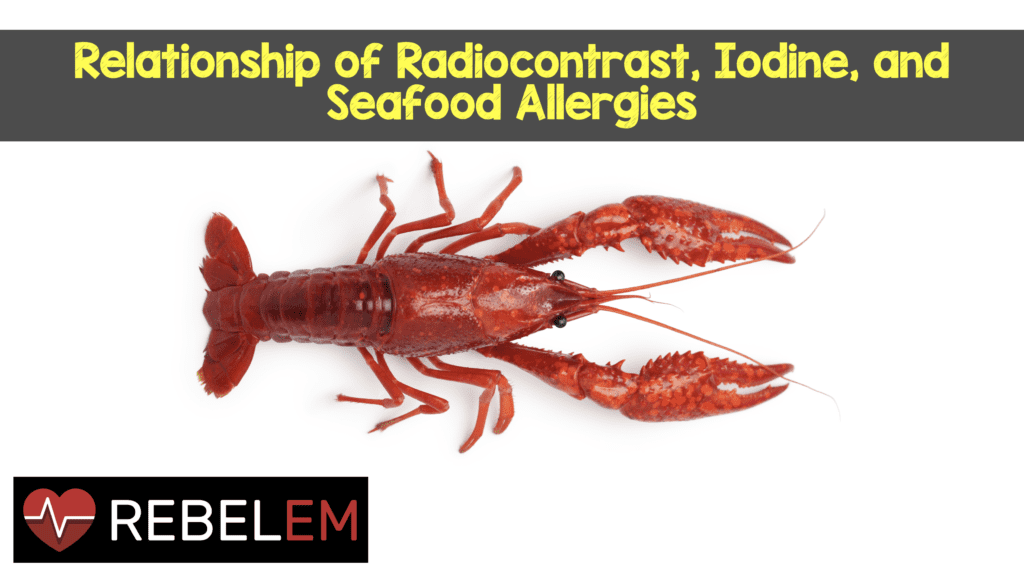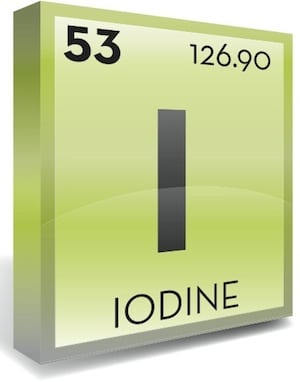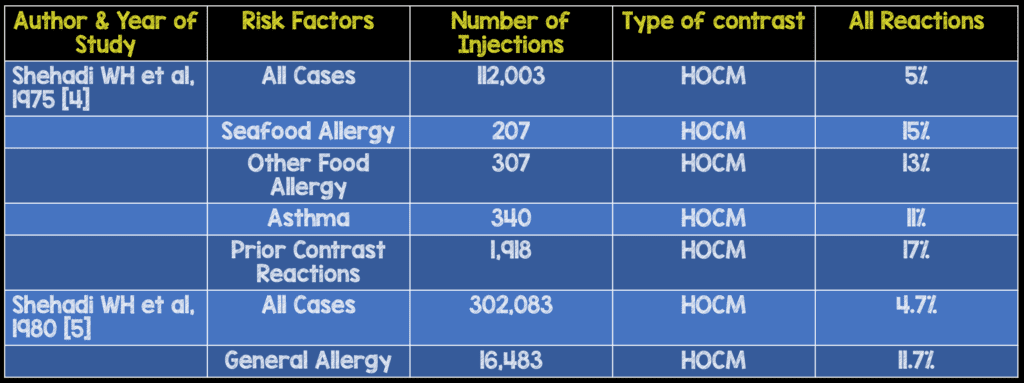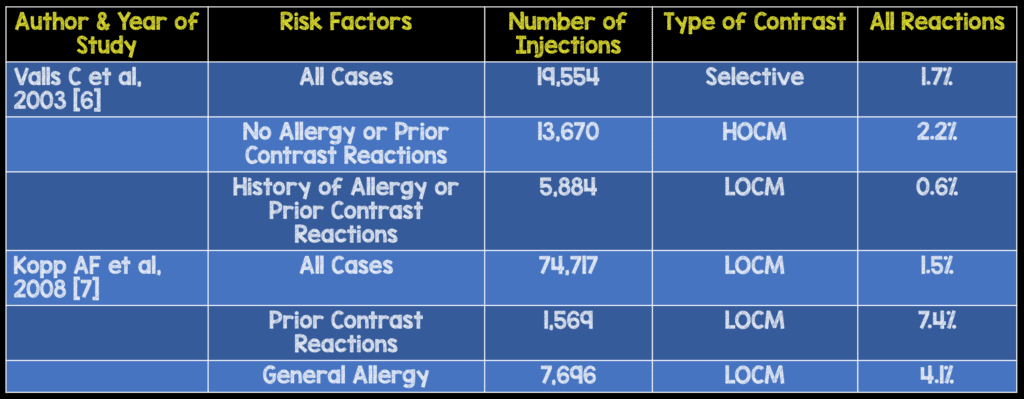
 Computed Tomography (CT) scan using radiocontrast is one of the most common imaging modalities used in emergency departments today. Several studies and my own anecdotal experiences indicate that both physicians and patients believe that iodine allergies are linked to seafood allergies and that both are related to a disproportionate increased risk of “allergic” reactions to radiocontrast agents. To add further insult to injury, some hospitals have premedication protocols with steroids and antihistamines requiring up to 12 hours before CT scans with intravenous contrast can be performed. So what is the relationship of radiocontrast, iodine, and seafood allergies?
Computed Tomography (CT) scan using radiocontrast is one of the most common imaging modalities used in emergency departments today. Several studies and my own anecdotal experiences indicate that both physicians and patients believe that iodine allergies are linked to seafood allergies and that both are related to a disproportionate increased risk of “allergic” reactions to radiocontrast agents. To add further insult to injury, some hospitals have premedication protocols with steroids and antihistamines requiring up to 12 hours before CT scans with intravenous contrast can be performed. So what is the relationship of radiocontrast, iodine, and seafood allergies?
How often do physicians ask about seafood allergies before giving radiocontrast agents? [1]
What they did:
- Yes/no survey was sent to 231 faculty radiologists and interventional cardiologists
- 8 questions were asked, but two were pertinent:
- Do you inquire about a history of seafood or shellfish allergy prior to administration of contrast media?
- Would you withhold radiocontrast or recommend premedication with steroids/antihistamines based on a history of seafood or shellfish allergy?
 Results:
Results:
- 65.3% of radiologists and 88.9% of cardiologists did inquire about a history of seafood and/or shellfish allergy
- 34.7% of radiologists and 50% of cardiologists would withhold radiocontrast or recommend premedication
Limitations:
- 48.9% response rate
- Non-standardized, informal survey
- No differentiation between low-osmolarity and high-osmolarity contrast agents were determined
Conclusion: Approximately 2/3 of responders would ask about a history of seafood and/or shellfish allergy and just over 1/3 would withhold radiocontrast or recommend premedication
What is the distinction between high and low-osmolarity radiocontrast agents? [2]
The first ionic contrast material was composed of mono-iodinated rings, to make the contrast radiopaque and mixed with sodium and/or meglumine (cations), due to the relative ease and inexpensiveness. This created a hyperosmolar solution relative to serum. The issue with this is that hyperosmolar material is a severe irritant and more likely to cause vasodilatation, increased capillary permeability, and mast cell degranulation. This early radiocontrast agents were termed high-osmolarity contrast media (HOCM).
Newer contrast agents use di and tri-iodinated rings mixed with non-ionic elements. Approximately 90% of iodinated contrast media used in the US are now non-ionic according to the American College of Radiology. Due to the lower osmolarity of these agents, fewer side effects are seen. These new radiocontrast agents are about 1/2 to 1/3 as osmotically active than HOCM, and more expensive to produce, but still only about 10 – 20 dollars per test. These newer radiocontrast agents are termed low-osmolarity contrast media (LOCM).
 Is iodine allergy fact or fiction? [2]
Is iodine allergy fact or fiction? [2]
- Iodine is found throughout our bodies in thyroid hormones and amino acids
- Iodine is even added to most salt used in the US to prevent iodine deficiency
- A person cannot survive without iodine in the body
- Iodine is also used in many antiseptic skin preparations (i.e. povidone)
- Fish and shellfish both contain iodine, but the major allergens are tropomyosins (shellfish) and parvalbumin (fish).
Conclusions:
- Iodine is not a component of tropomyosins and parvalbumin, therefore it is not the iodine that is the source of people’s allergies to seafood…Iodine is NOT an allergen!!!
- The cause of anaphylactoid reactions from radiocontrast is not from the iodine, but thought to be from the hyperosmolarity compared to blood
What is the difference between anaphylaxis versus anaphylactoid reactions? [2]
- Anaphylaxis: After exposure to an allergen, the immune system becomes sensitized by creating IgE specific to that allergen. When re-exposed, the allergen-IgE complex causes mast cells and basophils to degranulate, releasing histamines.
- Anaphylactoid: Exposure to an allergen causes mast cells and basophils to degranulate from direct stimulation and there is no IgE-mediated immune system triggering, so pre-exposure to an allergen is not needed to trigger these reactions. Radiocontrast can cause this type of reaction.
- Bottom Line: Both types of reactions can cause a similar clinical picture: urticaria, bronchospasm, hypotension, and even cardiac arrest; Both are treated essentially the same
What is the evidence behind patients having a seafood allergy are more likely to have radiocontrast allergy? [2]

Bottom Line: The risk of seafood allergy being a risk factor for radiocontrast allergy is about the same as having any type of allergy, atopy, and/or prior contrast reactions, compared to the general population, in patients receiving high-osmolar contrast media.

Studies of Risk Factors for Radiocontrast Allergy to Low-Osmolar Contrast Media (LOCM)
Bottom Line: There is still an increased risk of radiocontrast allergy in patients with any type of allergy, atopy, and/or prior contrast reactions, compared to the general population, with low-osmolar contrast media, but it is significantly less than high-osmolar contrast media.

Comparison of Reaction Rates Between HOCM and LOCM
Bottom Line: The use of Low-Osmolar Contrast Media (LOCM), has significantly reduced the number of allergic reactions compared to High-Osmolar Contrast Media (HOCM)
Conclusions:
- Patients with ANY allergies (not just seafood allergies), having a previous reaction to a contrast agent, or evidence of atopy (i.e. asthma) have an increased chance of radiocontrast allergies compared to the general population
- LOCM is associated with a four to five fold reduction in all reactions and severe reactions to radiocontrast compared to HOCM
Does premedication with steroids reduce the number of reactions from radiocontrast media? [3]

Pretreatment with Steroids to Prevent Contrast Allergy
Bottom Line: Steroid premedication has not been shown to decrease rate of severe reactions (i.e. immediately life-threatening or requiring hospitalization), but has been shown to reduce mild reactions.
Take Home Points:
- Seafood allergy confers the same risk of radiocontrast reaction as:
- ANY allergies (not just seafood allergies)
- Having a previous reaction to a contrast agent
- Evidence of atopy (i.e. asthma)
- Iodine is NOT an allergen!!!
- Low-Osmolar Contrast Media (LOCM) has significantly reduced the number of severe reactions to radiocontrast
- Premedication with steroids has not been shown to decrease the number of severe allergic reactions to radiocontrast
References:
- Beaty AD et al. Seafood Allergy and Radiocontrast Media: Are Physicians Propagating a Myth? Am J Med 2008. PMID: 18261505
- Schabelman E et al. The Relationship of Radiocontrast, Iodine, and Seafood Allergies: A Medical Myth Exposed. JEM 2010. PMID: 20045605
- Lasser EC et al. Pretreatment with Corticosteroids to Alleviate Reactions to Intravenous Contrast Material. NEJM 1987. PMID: 3627208
- Shehadi WH et al. Adverse Reactions to Intravascularly Administered contrast Media. A Comprehensive Study Based on a Prospective Survey. Am J Roentgeno Radium There Nucl Med 1975. PMID: 1170768
- Shehadi WH et al. Adverse Reactions to Contrast Media: A Report from the Committee on Safety of Contrast Media of the International Society of Radiology. Radiology 1980. PMID: 7433658
- Valls C et al. Selective Use of Low-Osmolality Contrast Media in computed Tomography. Our Radiology 2003. PMID: 12942301
- Kopp AF et al. Prevalence of Acute Reactions to Iopromide: Postmarketing Surveillance Study of 74,717 Patients. Acta Radiol 2008. PMID: 18651252
- Katayama H et al. Adverse Reactions to Ionic and Nonionic Contrast Media. A Report from the Japanese Committee on the Safety of Contrast Media. Radiology 1990. PMID: 2343107
- Cochran ST et al. Trends in Adverse Events After IV Administration of Contrast Media. AJR Am J Roentgenol 2001. PMID: 11373197
The post Relationship of Radiocontrast, Iodine, and Seafood Allergies appeared first on REBEL EM - Emergency Medicine Blog.
